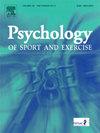Relationship between overall right pre-frontal cortex activity and learning and retention of a visuomotor adaptation task: A continuous analysis
IF 3.1
2区 心理学
Q2 HOSPITALITY, LEISURE, SPORT & TOURISM
引用次数: 0
Abstract
Learning a visuomotor adaptation task (VMA) is typically assessed by describing the behavioral changes during adaption (early-fast and late-slow phases) and retention (consolidation) tests. Few studies have concurrently examined behavioral and brain activity during this type of learning and therefore their time-dependent dynamics is unknown. It has been proposed that two distinct strategies can be used during such learning: a model-free and a model-based, which distinctively involved explicit and implicit learning strategies. It has also been proposed that prefrontal cortex (PFC) is more implicated when explicit processes are more relevant as it was observed in the early adaptation (Taylor & Ivry, 2014; Wolpe et al., 2020). Additionally, an explicit model-based strategy has been inferred when prefrontal (PFC) activity increases. Therefore, the study's aims were: (1) to examine the continuous temporal dynamics of behavior and right PFC activity during adaptation and retention of a VMA, and (2) to infer the implication of explicit processes during the learning of a VMA derived from right PFC activity. Eighteen young adults (24.22 ± 3.12 years) took part in this study. Continuous measures of the performance (the initial directional error, IDE, and the root mean square error, RMSE) of a rotational visuomotor adaptation task during an adaptation (AD) and two retention sets at 1 h (RT1) and 24 h (RT24) were collected. Concurrently, measures of the right PFC activity (relative changes of the oxyhemoglobin concentration, [ΔO2Hb]) were registered via a three-channel functional near-infrared spectroscopy device. General linear mixed models were run to explore differences across adaptation and retentions. Also, cross-correlations between performance (IDE and RMSE) and PFC activity were conducted to observe their relation during sets. The main results indicated that (1) initial fast behavioral improvement (decrease of IDE and RMSE) did not occur simultaneously with the largest increase of the [ΔO2Hb] in the PFC during the AD, and (2) there was similar performance in the RT1 and RT24 but possibly involving the PFC differently. While in both retentions the errors improved after the first trials, in RT1, the [ΔO2Hb] decreased from the very beginning, whereas the PFC activity initially increased in RT24. Our observations would suggest that various cooperating learning strategies, including model-free (i.e., exploratory) and model-based explicit (i.e., strategy) and implicit (i.e., sensory prediction errors), are coordinated in different timings to cooperate during the sensorimotor adaptation and consolidation processes. Furthermore, the involvement of these strategies during the retention may depend on the time elapsed from the end of the adaptation to the re-introduction of the task.
求助全文
约1分钟内获得全文
求助全文
来源期刊
CiteScore
6.40
自引率
5.90%
发文量
172
审稿时长
69 days
期刊介绍:
Psychology of Sport and Exercise is an international forum for scholarly reports in the psychology of sport and exercise, broadly defined. The journal is open to the use of diverse methodological approaches. Manuscripts that will be considered for publication will present results from high quality empirical research, systematic reviews, meta-analyses, commentaries concerning already published PSE papers or topics of general interest for PSE readers, protocol papers for trials, and reports of professional practice (which will need to demonstrate academic rigour and go beyond mere description). The CONSORT guidelines consort-statement need to be followed for protocol papers for trials; authors should present a flow diagramme and attach with their cover letter the CONSORT checklist. For meta-analysis, the PRISMA prisma-statement guidelines should be followed; authors should present a flow diagramme and attach with their cover letter the PRISMA checklist. For systematic reviews it is recommended that the PRISMA guidelines are followed, although it is not compulsory. Authors interested in submitting replications of published studies need to contact the Editors-in-Chief before they start their replication. We are not interested in manuscripts that aim to test the psychometric properties of an existing scale from English to another language, unless new validation methods are used which address previously unanswered research questions.

 求助内容:
求助内容: 应助结果提醒方式:
应助结果提醒方式:


